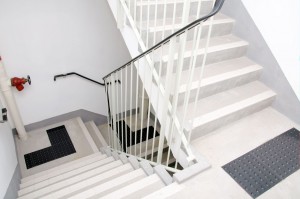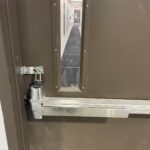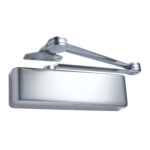This post was published in Doors & Hardware
In a previous column I explained how to calculate the required egress width based on the occupant load, and how to determine the number of occupants that a door opening will accommodate. The formulas used to calculate these values are consistent between the International Building Code (IBC) and NFPA 101 – The Life Safety Code, although the egress capacity factors vary slightly. So if you know the occupant load and the number of occupants accommodated by each door, it’s simple math to decide whether you have enough egress doors, right? Well…no.
As I mentioned in my previous column, there are other factors that affect the quantity and location of egress doors, beyond the general requirements for 2, 3, or 4 exits depending on the occupant load. For example, doors used for egress need to be located remotely from each other, and there are limitations on the distance a building occupant must travel to reach an exit. In order to understand these requirements, there is terminology that you should be familiar with.
- Means of Egress – This is the path between any occupied portion of the building and the public way. It must be continuous and unobstructed, and may include elements of vertical and horizontal travel (ex: stairs, ramps, and corridors). The means of egress has 3 parts:
- Exit Access – This segment of the means of egress is between the occupied portion of the building and the exit. If you imagine a typical school, the corridor that leads from the classrooms to a stair enclosure would be an exit access corridor. The path that you would travel through the classroom to reach the corridor would also be part of the exit access. Exit passageways are sometimes confused with exit access corridors, but an exit passageway is separated from the rest of the building by fire-resistance-rated construction and is part of the exit, not part of the exit access. Exit passageways often extend from the end of the exit stair to the exterior when the stair doesn’t discharge directly to the exterior.
- Exit – We often use the word “exit” as it is defined by the general definition – “a way out.” But in code terminology, an exit is the portion of the means of egress between the exit access and the exit discharge or public way. Some components that may be an exit are stairways and ramps, horizontal exits (often a double-egress pair of fire doors), exit passageways, and exterior exit doors at the level of exit discharge. In the school example, the enclosed stairway would be an exit.
- Exit Discharge – The portion of a means of egress between the end of the exit and the public way is the exit discharge, which typically begins when building occupants reach the exterior of the building, at or near grade level. If you reached the exterior door at grade level in the school example, the exit discharge might include a sidewalk leading from the exterior door to the street (the public way).

The exit access corridor is the portion of the means of egress that leads from the occupied portion of the building to the exit.
.
.
Other Terminology
When determining the quantity and location of egress doors, you will often find limitations that are imposed on the route.
- Travel Distance – The travel distance to an exit is measured on the floor along the natural path of travel, beginning at the most remote point, curving around corners or obstructions with a 12-inch clearance from the object, and ending at the beginning of the exit. The travel distance from a school classroom would be measured by starting in the most remote corner of the room, following the natural path to the door, traveling down the corridor, and ending at the stair door (the beginning of the exit). The IBC limits this distance in an educational occupancy to 200 feet for unsprinklered buildings, and 250 feet for sprinklered buildings. NFPA 101 allows a maximum of 150 feet for unsprinklered educational occupancies, and 200 feet for sprinklered educational occupancies.
- Common Path of Egress Travel – This is the distance that a building occupant must travel before two separate egress paths to two exits are available. In a classroom with one egress door, the common path of egress travel would be the path from the most remote location within the classroom out into the corridor where two paths become available – down the corridor to the left, or to the right. The common path of egress travel ends where that choice becomes available. In an educational occupancy, the IBC limits the length of the common path of egress travel to 75 feet. The maximum allowed by NFPA 101 for educational occupancies is 75 feet for unsprinklered buildings, and 100 feet for sprinklered buildings.
- Dead End Corridors – Where more than one exit or exit access doorway is required, the length of dead-end corridors (corridors with no outlet) are limited by the IBC and NFPA 101. In educational occupancies, the limit on the length of dead end corridors is 20 feet for unsprinklered buildings and 50 feet for sprinklered. In the IBC, the length of dead end corridors is not limited when the length of the dead end corridor is less than 2.5 times the width.
Another issue to consider when evaluating egress is the remoteness of exits. When two exits are required, they must be remote from each other, since two exits located in the same vicinity could become blocked during an emergency. To determine the minimum distance between exits, take the longest diagonal measurement of the area served by the exits. The distance between the exits must be at least one-half of the diagonal measurement for unsprinklered buildings, and at least one-third of the diagonal measurement for sprinklered buildings.
This article is not intended to be an in-depth study of each of these concepts, rather, an introduction to some of the egress-related terms that may affect the door openings serving an egress route. For additional information, refer to the code or standard that has been adopted in your jurisdiction. The allowable lengths shown in this article for travel distance, common path of egress travel, and dead end corridors are based on the 2021 editions of the IBC and NFPA 101. Values required by other editions may vary.
You need to login or register to bookmark/favorite this content.









Lori,
Well-written article. I have just one suggestion: In figuring Exit Access Travel Distance, we use the length and width of the room (less the 12 inch clearance at the walls) rather than the diagonal distance. It might seem that the natural path to the egress door would be the diagonal, being the most direct, but often there is furniture in the way. In your example of the school, the student at the desk in the corner of the classroom may have rows of desks in his way. Whether he goes up to the front of the room, and then across to the door, or up one desk and over one, then up one more and over one more, etc., it adds up the same: length plus width. I believe this is explained in the IBC Code Commentary.
There is a fantastic resource that I think is under-advertized to help designers tackle these kind of confusing issues. It’s called the Interactive Guide to the 2012 IBC, which sells for about $50.
No I don’t work for the ICC, but I am lucky enough to have a copy and the infographics are amazingly helpful for just this sort of thing. Check it out:
http://shop.iccsafe.org/interactive-guide-to-the-2012-ibcr-pdf-download.html
Lori
Article is well written and informative.